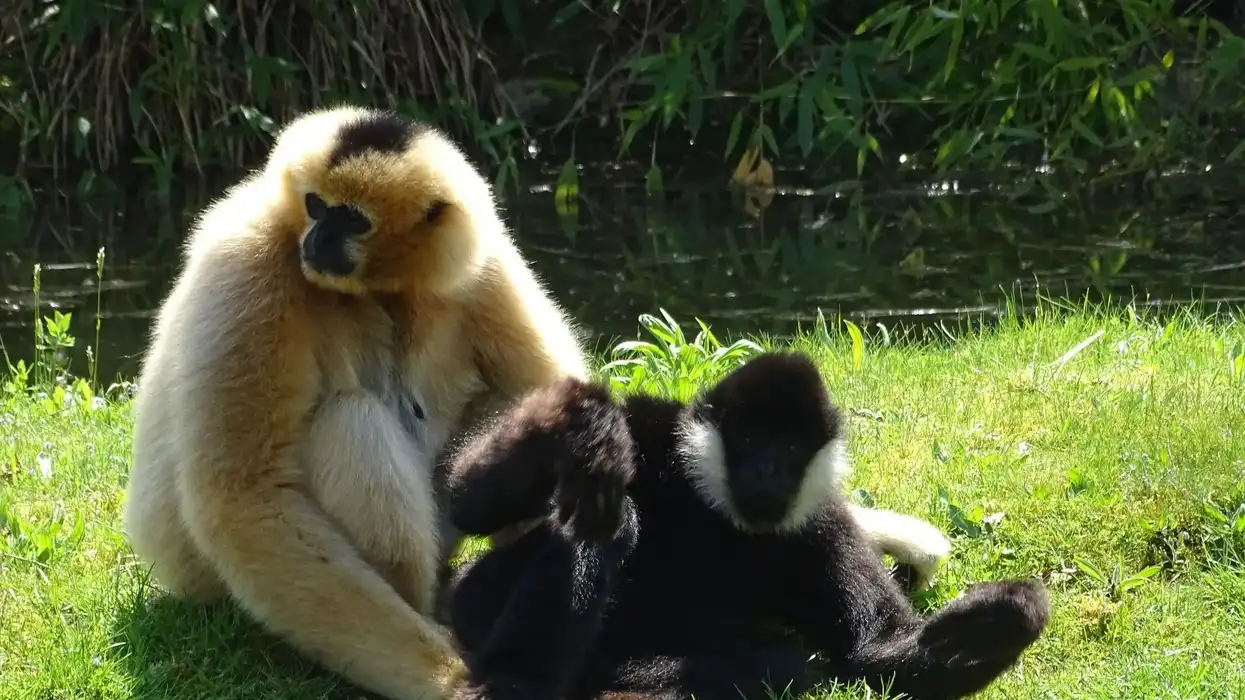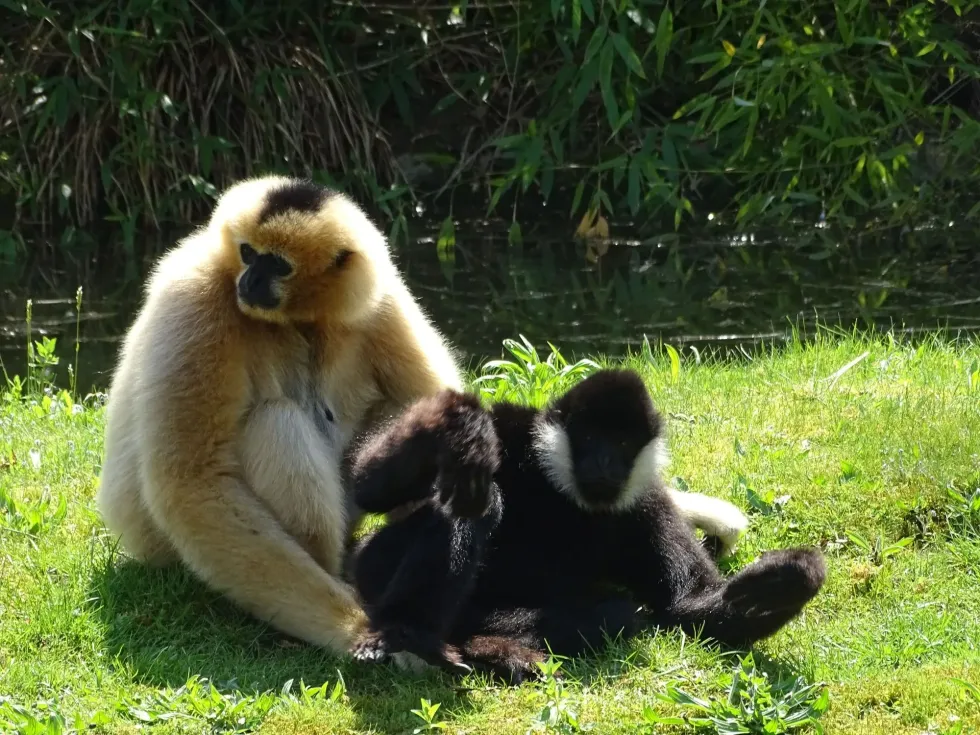Do you find gibbons fascinating, like the white-handed gibbon? Then here we have all the information on the northern white-cheeked gibbons. Northern white-cheeked gibbon is a species of animal that belongs to the order Primates.
They have been declared as a Critically Endangered species. These gibbons are quite fascinating as their body color changes with age. The infants are born cream-colored.
Then at two years of age, their body color changes and becomes black with white cheeks. Then after becoming sexually mature, the fur of the females again turns cream-colored while the male retains the black fur. They reach sexual maturity when they are around 6-7 years old, but attain physical maturity at about three years of age.
5-6 of these gibbons live in small groups. This group consists of a female and a male parent and 3-4 of their infants. Their primary food is flowers and insects.
Read on to know more about the northern white cheeked gibbon and if you like this article, then also check out Hainan gibbon and agile gibbon.
Northern White Cheeked Gibbon Interesting Facts
What type of animal is a northern white cheeked gibbon?
Northern white cheeked gibbon (Nomascus leucogenys) is a species of gibbon.
What class of animal does a northern white cheeked gibbon belong to?
Northern white cheeked gibbons belong to the order Primates, family Hylobatidae, and class Mammalia of animals.
How many northern white-cheeked gibbons are there in the world?
The northern white-cheeked gibbon population in an exact number is not known. However, the number is estimated to be only in the thousands. Their population is still showing a decreasing trend. They have even become extinct in some places within their habitat range.
Where does a northern white-cheeked gibbon live?
These gibbons are native to southeast Asia. They are mainly found in southern China, Vietnam, and Laos. In Vietnam, these gibbons live only on the southwestern side of the Song Bo and Song Ma rivers.
What is a northern white-cheeked gibbon's habitat?
Northern white-cheeked gibbons (Nomascus leucogenys) are arboreal animals. They are mostly found in the canopy of subtropical forests and very rarely on the forest floor.
Who does the northern white-cheeked gibbon live with?
This species of gibbons live in a family group. These families consist of a male, a female, and three or four offspring. At the top of their family hierarchy is the female or the mother, then the female offspring, male offspring, and lastly the male or the father.
How long does a northern white-cheeked gibbon live?
The average lifespan of northern white-cheeked gibbons is about 28 years in the wild.
How do they reproduce?
The breeding season of this gibbon species occurs throughout the year. Both males and females of these gibbons reach sexual maturity at about six to seven years of age and show monogamous nature.
Not much is known about the courtship behavior between the two sexes. After copulation, the gestation period lasts for about seven months and at the end of it, the females give birth to a single infant.
The offspring holds onto its mother for two years after that the parents start weaning the infant.
Unlike most other mammals, both adult male and female gibbons take part in parental care for the offspring. The infant matures physically at about three years of age and becomes fully independent when they are about six or seven years old.
What is their conservation status?
The status of the northern white cheeked gibbons (Nomascus leucogenys) according to the International Union for Conservation of Nature Red List is listed as Critically Endangered. The primary threat to this species within their habitat range is deforestation owing to the conversion of forests into agricultural fields, cutting down trees for the wood.
Some other threats are hunting these animals for pet trade, traditional medicine, and food. They are protected legally in China, Vietnam, and Laos. For preservation efforts, they are also listed in the CITES Appendix I.
Northern White Cheeked Gibbon Fun Facts
What does the northern white-cheeked gibbon look like?

Northern white-cheeked gibbons (Nomascus leucogenys) are very similar to crested gibbons and they were even considered as a subspecies of them, but the mohawk tuft on the head of these gibbons distinguishes them from crested gibbons. These gibbons are sexually dimorphic in terms of their fur color.
The infants usually have cream-colored fur. After two years of age, their fur turns black and they grow white fur on their cheeks. When they reach sexual maturity, the females start to lose their black fur and the females turn cream-colored again and they even lose their white cheek patches.
The males retain the black color of their fur. They do not have tails but possess hook-shaped hands, opposable pollex, and hallux.
How cute are they?
These gibbons may not look cute, but they would surely fascinate many people. They are also not known to be aggressive in nature.
How do they communicate?
These gibbons communicate vocally, by body language, and chemical means. They use vocal cues during mating. They have been observed to perform duets when mating. The males produce booming sounds whereas females produce rapid great calls during these duets.
When they are showing aggression, they show their teeth by widely opening their mouth. They also release pheromones to communicate their reproductive state. These gibbons groom and play among each other.
How big is a northern white-cheeked gibbon?
Adult northern white-cheeked gibbons are about 17.7-24.8 in (45-63 cm) on average. They are around two times larger than pileated gibbons, which are about 8-10 in (20.3-25.4 cm) in length.
How fast can a northern white-cheeked gibbon run?
These gibbons can reach a speed of about 35 mph (56.3 kmph). They move by swinging from one tree to the next with the help of their hands. The trees can be as far as 50 ft (15.2 m) apart from each other.
How much does a northern white-cheeked gibbon weigh?
Adult northern white-cheeked gibbons weigh about 12.6 lb (5.7 kg) on average.
What are the male and female names of the species?
The males and females of the species have no sex-specific names.
What would you call a baby northern white-cheeked gibbon?
Baby northern white-cheeked gibbons (Nomascus leucogenys) are called infants.
What do they eat?
These gibbons have an omnivorous diet. The primary northern white-cheeked gibbon diet consists of fruits of various plants.
Other times, their diet includes flowers, leaves, and even insects. These gibbons start to search for fruits early in the morning on high in the canopy and as the day progresses and temperatures start to go higher, they come down to the trees with lower heights.
Are they dangerous?
No, there are no reports of northern white-cheeked gibbons being aggressive or dangerous in any way to humans or otherwise.
Would they make a good pet?
No, they do not make good pets. This species of animal is wild in nature. They are also an endangered species, so it's better to not take them away from their natural habitat.
Did you know...
Northern white-cheeked gibbons have exceptionally long arms because they use them to swing from one tree to another. These long arms are so long that they hold them above their heads when walking.
They form territories and defend them as a group to protect themselves. Defending involves calling from the boundaries of these territories, chasing across these boundaries, confronting, and even fighting amongst the males around these boundaries.
Why is the northern white-cheeked gibbon endangered?
The major threats to northern white-cheeked gibbons (Nomascus leucogenys) are habitat degradation and habitat loss within their range. They have even become victims of hunting at a large scale which has even led to their extinction in some places.
Conservation actions are being taken, but they are still being hunted which has led to lesser population numbers. Hence, their reproduction rate has also decreased.
How many types of gibbons are there?
There are more than 20 species of gibbons in the world. Some of them are siamang gibbon, hoolock gibbon, Hainan gibbon, agile gibbon, silvery gibbon, lar gibbon, and more. They differ from each other owing to the color of their fur, geographic range, habitat, feeding habits, or social behavior.
Here at Kidadl, we have carefully created lots of interesting family-friendly animal facts for everyone to discover! For more relatable content, check out these hoolock gibbon facts and gibbon facts for kids.
You can even occupy yourself at home by coloring in one of our free printable monkey coloring pages.
Both images by Ad Meskens.









